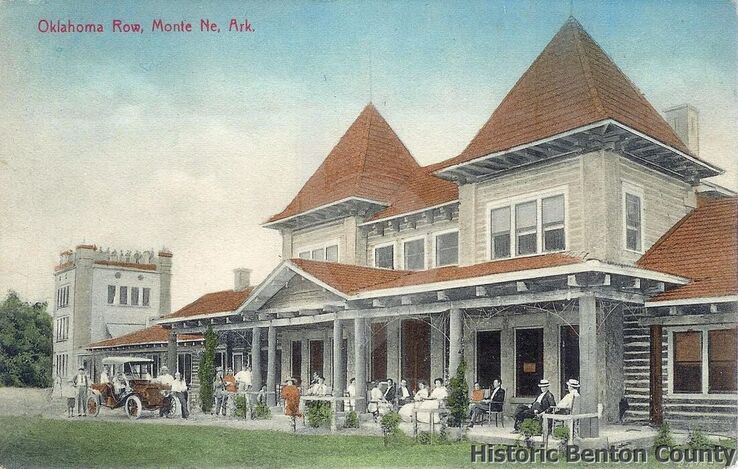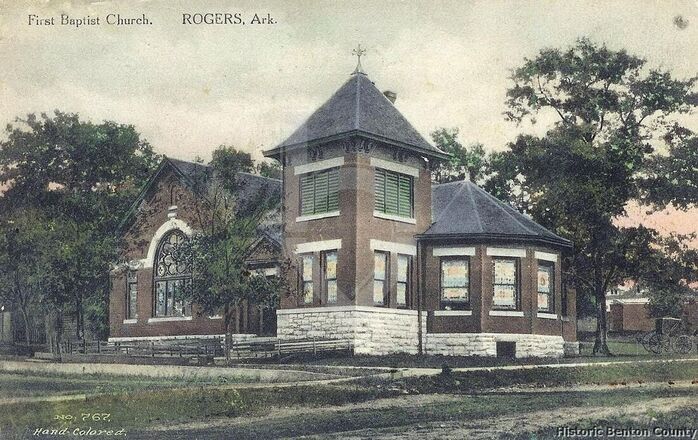Writer Paints Glowing Picture Of The Future On the City's [Rogers] 15th Anniversary
Believed to be from The Rogers Daily News, now the NWA Democrat Gazette
Believed to be from The Rogers Daily News, now the NWA Democrat Gazette
The city of Rogers observed its 15th anniversary on May 10, 1896, and to commemorate the occasion the Arkansas Standard, a magazine published here by J. M. Cain, featured an article by Lafe Merritt in which he painted a glowing picture of the city's charms.
The article appeared under the title: Rogers Arkansas. Proud Town of the Ozarks -- In Tribute One Offering Let Fond Love Bestow. A Lovely City in the Sun-Kissed Vale of the Semi-Tropical South, Where Prosperity's Suns Never Vary and Love for the Beautiful Forever Will Grow.
The Arkansas Standard's article follows:
Lovely, arborescent Rogers - the very name falls upon the ear with a peculiar and fascinating charm, recalling the heroic life and worthy efforts of the late venerable C. W. Rogers, general manager of the St. Louis and San Francisco Railway, in whose honor the town was named.
A resplendent scene of ineffable beauty and grandeur opens before the enraptured gaze of the traveler as the train enters Rogers, over hill and dale, to dash with sudden transformation of scenery into this beautiful vale of sun-kissed region of the semi-tropical South.
The article appeared under the title: Rogers Arkansas. Proud Town of the Ozarks -- In Tribute One Offering Let Fond Love Bestow. A Lovely City in the Sun-Kissed Vale of the Semi-Tropical South, Where Prosperity's Suns Never Vary and Love for the Beautiful Forever Will Grow.
The Arkansas Standard's article follows:
Lovely, arborescent Rogers - the very name falls upon the ear with a peculiar and fascinating charm, recalling the heroic life and worthy efforts of the late venerable C. W. Rogers, general manager of the St. Louis and San Francisco Railway, in whose honor the town was named.
A resplendent scene of ineffable beauty and grandeur opens before the enraptured gaze of the traveler as the train enters Rogers, over hill and dale, to dash with sudden transformation of scenery into this beautiful vale of sun-kissed region of the semi-tropical South.
Downtown Rogers postcard from around 1910
Rogers is one of the most beautifully located cities that the eye ever looked upon, standing as it does on the summit of a commanding elevation, a spur of the Ozark mountains, overlooking rich valleys and a prolific expanse of adjacent country - the agricultural granary of Arkansas and the apple orchard of America. Standing as it does at an altitude of over 1,500 feet above sea level, the air is always light and pure and the surroundings desirably healthful.
Fictitious prices for realty will never prevail in Rogers to hinder growth and prosperity, owing to its large area and general distribution of business interests and desirable residence portions.
The original townsite contained a half section which was conveniently platted, the streets crossing at right angles with the railroad, all afford a commodisous thoroughfare, the streets being 80 feet wide, while none of the residence streets are less than 50 feet in width. The entire townsite is profusely dotted with native forest trees and the lawns are bowers of beauty. A number of additions have been made to the original townsite giving Rogers a large area over which to spread.
It is not claimed for Rogers that it will ever be a great metropolis, but is a city of homes, and one of the most desirable places of residence of which the mind can conceive.
We have a salubrious climate, healthful surroundings, superior school facilities, churches, and a center of culture and refinement.
Home is the dearest and sweetest place on earth and all of these advantages have a tendency to throw a Christian enlightened influence about the home, and draw a superior class of immigration.
The present population of Rogers is estimated at 3,000...
The substantial business interests of Rogers together with the future possibilities along that line point to the growth of a city from eight to ten thousand within the next few years. The country is immediately tributary of Rogers has natural resources sufficient to support a city of manufactories and diversified interests of 10,000 people. Here is located Rogers Academy with its two commodious brick buildings costing upward of $30,000 and a campus of 15 acres. It is one of the leading educational institutions of the state, having an efficient corps of instructors. The town also has a splendid public school, a model brick building.
Fictitious prices for realty will never prevail in Rogers to hinder growth and prosperity, owing to its large area and general distribution of business interests and desirable residence portions.
The original townsite contained a half section which was conveniently platted, the streets crossing at right angles with the railroad, all afford a commodisous thoroughfare, the streets being 80 feet wide, while none of the residence streets are less than 50 feet in width. The entire townsite is profusely dotted with native forest trees and the lawns are bowers of beauty. A number of additions have been made to the original townsite giving Rogers a large area over which to spread.
It is not claimed for Rogers that it will ever be a great metropolis, but is a city of homes, and one of the most desirable places of residence of which the mind can conceive.
We have a salubrious climate, healthful surroundings, superior school facilities, churches, and a center of culture and refinement.
Home is the dearest and sweetest place on earth and all of these advantages have a tendency to throw a Christian enlightened influence about the home, and draw a superior class of immigration.
The present population of Rogers is estimated at 3,000...
The substantial business interests of Rogers together with the future possibilities along that line point to the growth of a city from eight to ten thousand within the next few years. The country is immediately tributary of Rogers has natural resources sufficient to support a city of manufactories and diversified interests of 10,000 people. Here is located Rogers Academy with its two commodious brick buildings costing upward of $30,000 and a campus of 15 acres. It is one of the leading educational institutions of the state, having an efficient corps of instructors. The town also has a splendid public school, a model brick building.
This is an image of the old Rogers Academy building, built in 1884. Elizabeth Hall, a girls dormitory was added in 1892. These buildings were operated at as an academy until 1914 when the building was sold to the Rogers Public Schools. It then operated until 1936 when the building was torn down for a new school. Today Tillery Elementary School sits on the property.
There are no capitalists or shylocks in Rogers, no eastern capital being used at this place. The city is composed of "middle classes" as regards wealth, nearly every family owning their homes and business men their property. The general appearance of the city is neat and tasty, many beautiful residences ornamenting every portion of the town.
Rogers has more churches in proportion to population than any town in the state, has better hotels, the most magnificent business buildings, firmer banks, better schools and the most substantial business firms, and her merchants have better ratings. There are about 30 two and three-story brick business houses on the business streets, all occupied.
Six churches rear their spires heavenward, as an evidence of a Christian enlightened community and chaste surroundings. Sunday schools and the usual auxiliary societies are organized with devoted men and women who lend their time and substance to the cause.
Rogers has more churches in proportion to population than any town in the state, has better hotels, the most magnificent business buildings, firmer banks, better schools and the most substantial business firms, and her merchants have better ratings. There are about 30 two and three-story brick business houses on the business streets, all occupied.
Six churches rear their spires heavenward, as an evidence of a Christian enlightened community and chaste surroundings. Sunday schools and the usual auxiliary societies are organized with devoted men and women who lend their time and substance to the cause.
Here is a postcard of the old First Baptist Church. This church was later destroyed by fire.
The Rogers Historical Museum now sits on this property.
The Rogers Historical Museum now sits on this property.
The secret and fraternal orders represented here are the Masons, Odd Fellows, Knights of Pythias, G. A. R., and A. O. U. W.
The municipal government of Rogers would serve as a model for many metropolitan cities, and put a liberal construction on the general welfare clause of the Constitution. The city's finances are in good condition, there being no bonded indebtedness. The tax is less than three mills.
This speaks well for the financial policy of the municipal officers. Very little of the public funds are paid out for salaries, the greater part being appropriated to the streets and public improvements.
Light taxes and a well organized municipal government is a wonderful stimulus to the progress of a city, and Rogers is blessed with these most favorable conditions.
Bon Ingersoll, in speaking of the grand old state of Arkansas, gave vent to this beautiful apothogem; "In this ocean of land and at nearly its center stands the imperial state of Arkansas. All admit that in natural resources it leads the rest and will become the crown and glory of the Union."
Fairest among her counties is rich and glorious Benton, and fairest among her cities is Rogers. The long summer evenings of this climate made fragrant by the gentle blowing zephyrs that steal through the valley; the soft vesper songs of the mockingbirds, as they warble their farewell hymns to departing day; the mellow light of the southern moon, throwing a mantling glory upon the scene as peaceful as that which first opened before the daze of our progenitors in the Garden of Eden, fills the residents of Rogers with a veneration for their favored town that never leaves them. Few, if any, who have lived here are ever satisfied elsewhere, and nearly all sooner or later return.
The municipal government of Rogers would serve as a model for many metropolitan cities, and put a liberal construction on the general welfare clause of the Constitution. The city's finances are in good condition, there being no bonded indebtedness. The tax is less than three mills.
This speaks well for the financial policy of the municipal officers. Very little of the public funds are paid out for salaries, the greater part being appropriated to the streets and public improvements.
Light taxes and a well organized municipal government is a wonderful stimulus to the progress of a city, and Rogers is blessed with these most favorable conditions.
Bon Ingersoll, in speaking of the grand old state of Arkansas, gave vent to this beautiful apothogem; "In this ocean of land and at nearly its center stands the imperial state of Arkansas. All admit that in natural resources it leads the rest and will become the crown and glory of the Union."
Fairest among her counties is rich and glorious Benton, and fairest among her cities is Rogers. The long summer evenings of this climate made fragrant by the gentle blowing zephyrs that steal through the valley; the soft vesper songs of the mockingbirds, as they warble their farewell hymns to departing day; the mellow light of the southern moon, throwing a mantling glory upon the scene as peaceful as that which first opened before the daze of our progenitors in the Garden of Eden, fills the residents of Rogers with a veneration for their favored town that never leaves them. Few, if any, who have lived here are ever satisfied elsewhere, and nearly all sooner or later return.



